Pleione, 28 Tauri (28 Tau), is a binary star system located in the constellation Taurus. It is one of the brightest members of the Pleiades cluster (M45), one of the brightest and most prominent open clusters in the sky. Pleione has an apparent magnitude of 5.048 and lies at an approximate distance of 392 light years from Earth.
Star system
Pleione is a binary star consisting of a young, hot class B star and a companion whose properties are uncertain. The primary component, formally named Pleione, is a main sequence star with 3.4 solar masses and a size of 3.2 solar radii. With an effective temperature of 12,000 K, it shines with 190 solar luminosities.
The spectral type given for the primary component is B8Vne (indicating a hydrogen-fusing dwarf) or B8IVpe (indicating a subgiant), depending on the source. The suffix “pe” indicates peculiarity in emission lines, referring to emissions that come from circumstellar disks of material expelled by the star. The “ne” indicates a fast spinner classified as a Be star, a B-type star with emission lines in its spectrum, suggesting the presence of an equatorial disk of gas. Some sources add the suffix “ev,” indicating variability in the star’s spectral emission.
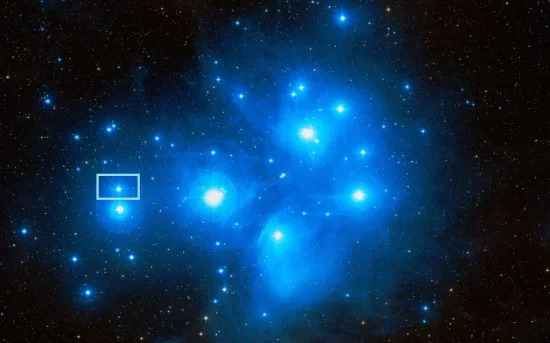
Pleione (28 Tauri), image: Wikisky
Classified as a Be star and a Gamma Cassiopeiae variable, Pleione has the variable star designation BU Tauri along with the Flamsteed designation 28 Tauri. Gamma Cassiopeiae variables are stars whose brightness varies by about a magnitude over the course of several decades. The variations are caused by shell features that appear in their spectra. These are hot, rapidly rotating stars, most of them classified as Be stars, with decretion disks around the equator. As the disks change or disappear at times, the stars’ brightness increases or decreases. Pleione exhibits periodic changes due to two circumstellar disks positioned at different angles. Its brightness varies from magnitude 4.8 to 5.5.
The star is an exceptionally fast spinner, with a projected rotational velocity of 329 km/s. This means that it rotates close to its breakup velocity, even faster than Regulus (318 km/s) and Achernar (250 km/s). The breakup velocity for its spectral class (B8V) is between 370 and 390 km/s. As a fast rotator, the star has a strong stellar wind and is losing mass at a high rate. It completes a revolution every 11.8 hours. In comparison, Achernar takes 48.4 hours, while the Sun turns on its axis every 25.3 days.
Pleione was discovered to be a single-lined spectroscopic binary star in 1996. The angular separation between the two stars, as given by the Washington Double Star Catalogue, is 0.2 arcseconds, which translates into a physical distance of 24 astronomical units. The stars have an orbital period of 218 days.
While the companion’s properties are unknown, Pleione has been the subject of many studies. The star is quite unique because it exhibits three distinct phases, appearing as a typical B-type star, a Be star, and a Be shell star. This is thought to be a result of two gaseous disks that appear and disappear at times, and sometimes reform later. In the last century, Pleione has had several phase changes: it appeared as a Be star until 1903, a B star from 1905 to 1936, a Be shell star from 1938 to 1954, a Be star from 1955 to 1972, a Be shell star from 1972 until the late 1980s, and a Be star from 1989 until 2005.
Observations conducted from 2005 to 2007 revealed that a new equatorial disk has formed around the star at an inclination of 60°. The existing disk was inclined at about 30°. The double-disk structure with disks positioned at different angles had not been observed in any star before, making Pleione a target for astronomers looking to study the formation of a new disk and the interaction between the two misaligned disks.
Pleiades
Pleione is the seventh brightest member of the Pleiades cluster. Of the nine brightest stars in the cluster, only Pleione and Asterope are still on the main sequence, fusing hydrogen in their cores, while the other seven are either subgiants or giants.
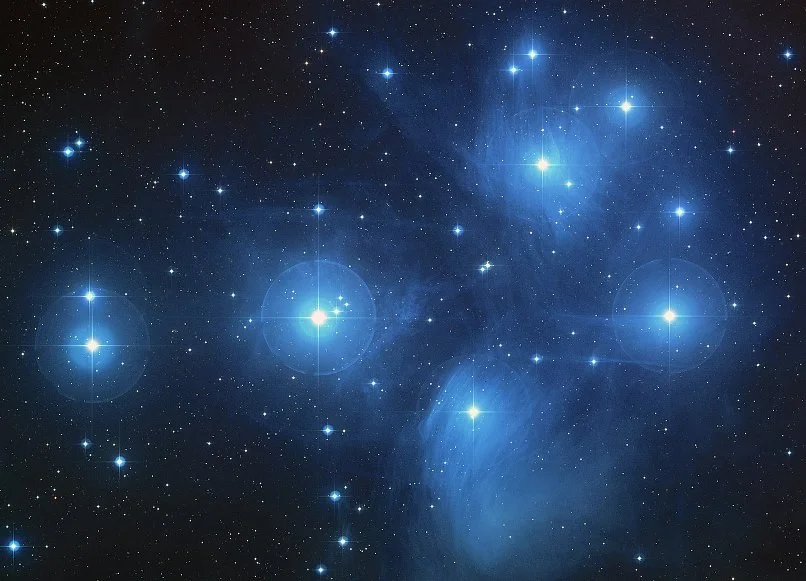
The Pleiades (M45), image: NASA, ESA, AURA/Caltech, Palomar Observatory, credit: D. Soderblom and E. Nelan (STScI), F. Benedict and B. Arthur (U. Texas), and B. Jones (Lick Obs.)
The open cluster contains over a thousand confirmed members and many more faint and unresolved stars. It has an estimated mass of 800 solar masses. The dimmer and redder members contribute the most to the cluster’s total mass, but most of its light comes from the hot, young blue stars like Pleione and other named Pleiades, that formed in the last 100 million years. About a quarter of the cluster members may be brown dwarfs, but they constitute under 2 percent of the total mass.
The core of the Pleiades cluster stretches for about 8 light years and the cluster’s tidal radius spans about 43 light years. The stars lie at an average distance of 444 light years from the Sun.
The cluster is commonly known as Messier 45. The French astronomer and comet hunter Charles Messier included it as the 45th entry in his catalogue of astronomical objects that may be mistaken for comets. Like Praesepe (Messier 44) and the Andromeda Galaxy (Messier 31), M45 has been well-known since ancient times, which makes Messier’s inclusion of these objects curious.
The cluster’s brightness and proximity make it appear particularly large. M45 stretches across an area of 110 arcminutes. With an apparent magnitude of 1.6, it is one of the most prominent objects of its kind, along with the nearby Hyades. On an exceptionally clear night, up to 14 Pleiades stars can be seen without binoculars, but observers can normally make out only six to eight members.
The Pleiades stars formed in the same molecular cloud and have been moving together through space for 100 million years. They will keep travelling together for another 250 million years before the cluster gradually disperses due to interactions with the surrounding medium. The stars are currently moving in the direction of Orion’s feet.
The brightest stars in the cluster are named after the Pleiades, the Seven Sisters in Greek mythology – Alcyone (Eta Tauri), Asterope (21 Tauri), Celaeno (16 Tauri), Electra (17 Tauri), Maia (20 Tauri), Merope (23 Tauri) and Taygeta (19 Tauri) – and their parents Atlas (27 Tauri) and Pleione (28 Tauri).
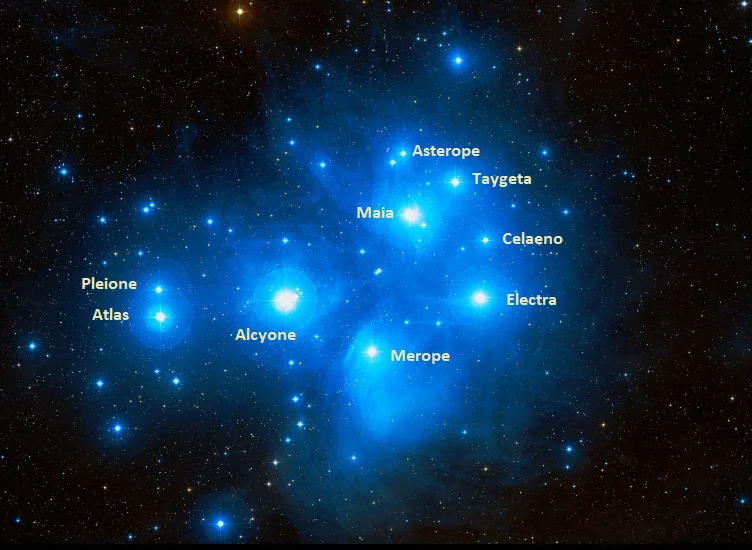
The Pleiades, image: Wikisky
In mythology, Pleione’s seven daughters caught the eye of Orion, the hunter. After Atlas, their father, was condemned to carry the heavens on his shoulder, Orion started pursing the sisters. Zeus decided to protect them from Orion’s advances and first transformed them into doves and later into stars to comfort their father. It is said that Orion, the constellation, still follows the Pleiades across the sky.
Facts
The Pleiades have been known to observers around the world since ancient times. The earliest known image of the cluster, found on the Nebra sky disk, dates back to the Bronze Age. The artifact, dating back to around 1600 BCE, was discovered in Germany. The cluster is mentioned in a number of ancient texts, including the Bible, Homer’s Iliad and Odyssey, and Hesiod’s Works and Days.
The Italian astronomer, physicist and engineer Galileo Galilei was the first to observe the stars of M45 in a telescope. He found that the cluster contained a great number of stars that were too faint to be visible to the unaided eye. Galilei published his observations and a sketch of the Pleiades in March 1610. The sketch depicted 36 stars.
The French astronomer Edme-Sébastien Jeaurat drew a map of 64 cluster members in 1782 and published it in 1786.
The Japanese know the cluster as Subaru. The car company of the same name uses an image of the six brightest Pleiades in its logo. In the 8th century Kojiki, an early compilation of Japanese myths, legends and oral traditions, the Pleiades were mentioned as Mutsuraboshi, “six stars.”
Name
The name Pleione (pronunciation: /ˈpliːəniː/ or /ˈplaɪəniː/) comes from Greek mythology. Pleione (Greek: Πληιόνη or Πλειόνη) was an Oceanid nymph, one of the three thousand daughters of the Titans Oceanus and Tethys. Pleione married Atlas, the Titan who was later condemned to carry the heavens on his shoulders, and gave birth to the Hyades (the “rain-makers”), the archer Hyas, and the Pleiades.
The names Pleione and Pleiades are both derived from the Greek πλεῖν, “to sail.” This is why Pleione is sometimes known as the “sailing queen” and the Pleiades as the “sailing ones.” The name Pleione may also be derived from Πλειόνη, meaning “plenty,” “many,” or “more,” while Pleiades may come from Πελειάδες, meaning “doves.” The latter is a reference to the myth of the sisters being transformed into doves by Zeus.
The name Pleione was officially approved by the International Astronomical Union’s (IAU) Working Group on Star Names (WGSN) on June 30, 2016. It formally applies only to the component 28 Tauri Aa.
Location
Pleione lies in the eastern part of the Pleiades cluster, just above Atlas. The stars are less than 5 arcminutes apart. Being considerably fainter than Atlas (mag. 3.63), Pleione is difficult to make out without binoculars, even though it is visible to the unaided eye.
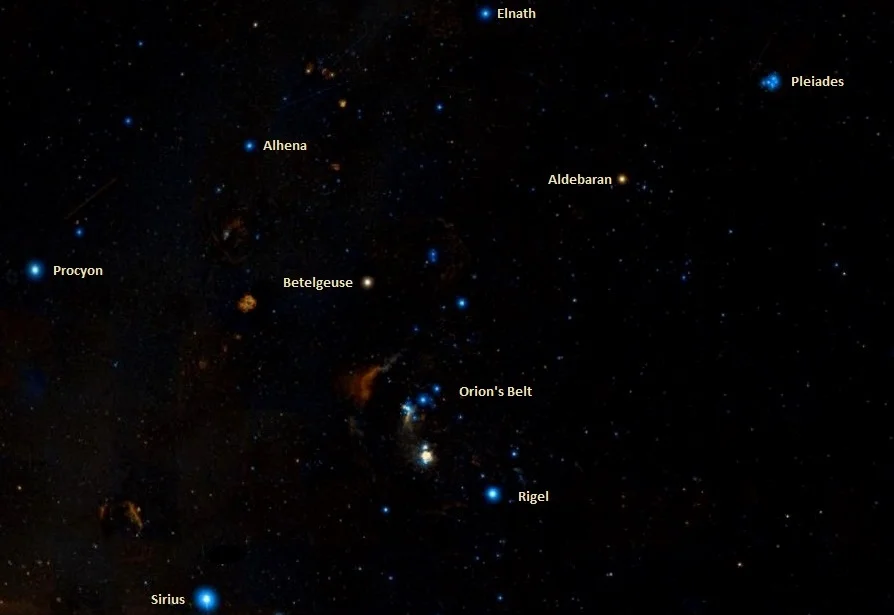
Pleiades location, image: Wikisky
The Pleiades are one of the most conspicuous features of the night sky, appearing as a bright bunch of grapes near Orion. The cluster can be found by extending an imaginary line from the three stars of Orion’s Belt, Alnitak, Alnilam and Mintaka, past the bright Aldebaran.
The cluster is conspicuous in the sky from October to April. It is invisible in May and June because it is too close to the Sun. In the late summer, it can be seen rising in the east in the early morning hours. During the northern winter months, Pleione is visible from all locations north of latitude 66° S.
Constellation
Pleione is located in the constellation Taurus, the Bull. Easily recognizable for the bright Aldebaran and the two prominent open clusters, the Pleiades and the Hyades, Taurus has been known to observers for millennia. The Pleiades cluster marks the Bull’s shoulder, while the Hyades outline its V-shaped head. Aldebaran marks the Bull’s eye, appearing as the brightest member of the Hyades, even though it lies much closer to us and is not physically related to the cluster.
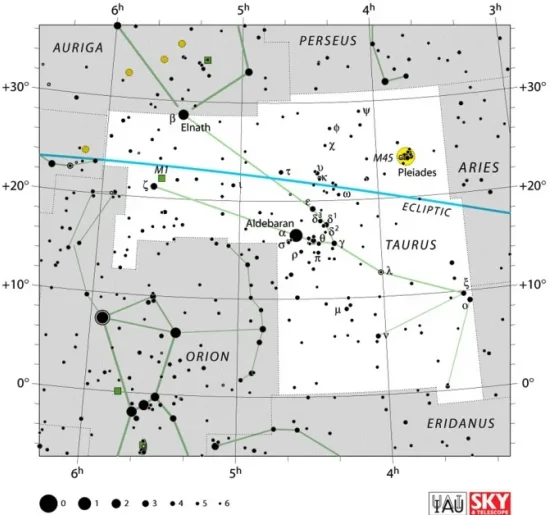
Taurus constellation map by IAU and Sky&Telescope magazine
Taurus is one of the largest northern constellations, stretching across an area of 797 square degrees. In addition to the two famous open clusters, it contains the bright historic supernova remnant Messier 1, also known as the Crab Nebula, the supernova remnant Sh2-240 (the Spaghetti Nebula), the planetary nebula NGC 1514, nicknamed the Crystal Ball Nebula, and the reflection nebula NGC 1555, known as Hind’s Variable Nebula because its brightness varies much like that of the star that illuminates it. Other notable deep sky objects in Taurus include the open clusters NGC 1647 and NGC 1817, and the interacting pair of galaxies catalogued as NGC 1409 and NGC 1410.
The best time of year to observe the stars and deep sky objects in the constellation is during the month of January.
The 10 brightest stars in Taurus are Aldebaran (Alpha Tau, mag. 0.86), Elnath (Beta Tau, mag. 1.65), Alcyone (Eta Tau, mag. 2.87), Tianguan (Zeta Tau, mag. 2.97), Chamukuy (Theta2 Tauri, mag. 3.40), Lambda Tauri (mag. 3.47), Ain (Epsilon Tau, mag. 3.53), Omicron Tauri (mag. 3.61), Atlas (27 Tau, mag. 3.63), and Prima Hyadum (Gamma Tau, mag. 3.654).
Pleione – 28 Tauri
| Spectral class | B8Vne/B8IVpe |
| Variable type | Gamma Cassiopeiae |
| B-V colour index | −0.08 |
| Apparent magnitude | 5.048 |
| Distance | 392 ± 6 light years (120 ± 2 parsecs) |
| Parallax | 8.32 ± 0.13 mas |
| Radial velocity | 4.4 km/s |
| Proper motion | RA: 18.71 mas/yr |
| Dec.: -46.74 mas/yr | |
| Mass | 3.4 M☉ |
| Luminosity | 190 L☉ |
| Radius | 3.2 R☉ |
| Temperature | 12,000 K |
| Rotational velocity | 329 km/s |
| Constellation | Taurus |
| Right ascension | 03h 49m 11.2161s |
| Declination | +24° 08′ 12.163″ |
| Designations | Pleione, 28 Tauri, 28 Tau, BU Tauri, HD 23862, HR 1180, HIP 17851, GC 4587, GCRV 2172, SAO 76229, BD+23°558, IRAS 03462+2359, 2MASS J03491121+2408120, PPM 92936, AAVSO 0343+23, WDS J03492+2408Aa,Ab, TYC 1800-2200-1, Gaia DR2 66529975427235712 |